Telecrawler market continues to diversify
18 September 2023
Hannah Sundermeyer reports on the uptick in usage of telescopic crawler cranes across North America.
The telecrawler market has diversified, now touching many different sectors of the lifting industry.
“What used to be primarily a small, niche market for powerline construction and tank builders has evolved into bridge construction, foundation work, wind and large lattice crawler support, marine and railroad applications among others,” said James Land, sales director, Tadano. “These used to be owned primarily by specialty contractors, but now they are a big part of the largest crane rental houses in the country. There is also a consistent need for special projects related to these cranes. Many customers want to do something outside of the norm with these machines, so we see a constant need for engineering involvement.”
Additionally, there is still a large portion of the industry still learning what these hybrid cranes can accomplish.
“Once you get them in the seat of these cranes, they start to realize the versatility and immense capabilities compared to a rubber-tired or lattice type machine,” added Land.
ACT reached out to the major telescopic crawler manufacturers across North America to learn more about the highs and lows of the market, what users can expect from these hybrid machines and the latest models.
Versatile and reliable
Link-Belt characterizes the market for telescopic crawlers as consistent, with some modest growth expected year-over-year.
“We’ve seen demand fluctuate among the different classes of telescopic crawlers,” said Brian Elkins, product manager for telescopic crawler cranes, Link-Belt. “Based on market activity, wind and heavy civil drive larger cranes. Link-Belt provides a variety of sizes, classes and boom options, which can meet the varying market needs.”
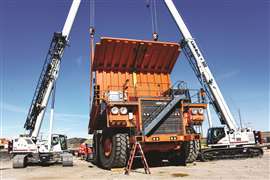
Link-Belt TCC-800
Capacity of crane: 80 tons
Main boom length: 120 feet
Fixed Jib Length: 35 to 58 feet
Maximum Line Speed: 449 fpm
Boom Length with jibs: Maximum Combination 120 + 58 feet
Total Tip Height: 185 feet
Counterweight: 38,500 pounds
Link-Belt telecrawlers in the small to medium size class are often utilized for foundation, bridge, industrial, energy and general construction.
“Their appeal continues to grow as they continue to become more mainstream for contractors,” added Elkins.
From the manufacturing side, supply chain issues are common across most product categories, but are definitely improving.
Access and egress to jobsites continues to be a challenge for contractors. Growth in the telecrawler class stems in large part to their ability to meet these challenges of mobility and maneuverability around a tight jobsite. They are becoming increasingly more common in road and bridge projects where pulling in the boom and traveling beneath overpasses is necessary. Another advantage of the telescopic crawler crane is its speed and mobility. Operators are able to move around a jobsite with limited setup. Telecrawlers can move on to the next job quicker than conventional cranes.
Link-Belt’s TCC-800 is equipped with a Stage 5 dual-compliant Cummins QSB 6.7 engine, which generates 232 horsepower at 2000 RPM and significantly improves fuel efficiency. The TCC-1200 offers an impressive capacity chart at radius that rivals even lattice crawler cranes with a similar base rating, the company said. The TCC-1200 has a full power boom, fabricated from ultra-high-strength steel and formed in Link-Belt’s own formed boom facility. It will come with three track widths – extended (18 feet 2 inches) intermediate (15 feet 8 inches) and retracted (11 feet 11 inches) which offers varying footprint capability. The TCC-1400 is designed for optimal control, ensuring dependable performance and load capacity on any type of terrain. The TCC-1400 moves quickly and easily on or off the jobsite, Link-Belt said. The main load of the TCC-1400, on the trailer weighs under 97,000 pounds.
Link-Belt’s telescopic crawlers cranes range in capacity from 55 to 250-tons (TCC-550, TCC-800, TCC-1200, TCC-1400 and TCC-2500) with boom lengths from 35 feet to 223 feet. One of the key advantages of a telescopic crawler crane is its ability to operate in a wide range of environments. With its extendable tracks, it can traverse rough terrain and uneven surfaces. Additionally, multiple counterweight configurations, boom lengths and transport scenarios make telecrawlers a versatile and reliable tool.
Breaking the mold
Manitowoc has seen substantial growth in their product family of Grove GHC cranes.
“The launch of our latest model, the GHC85, has been a huge success,” said JJ Grace, product manager, Manitowoc. “Its excellent pick-and-carry charts out of level and long boom are two factors that have contributed to its success.”
However, the company has faced the challenge of getting customers to break the tradition of always using certain style cranes and trying a telescopic crawler.
“Once they try it, they realize all of the benefits they were missing out on,” added Grace. “In certain applications, it could be not having to disassemble and reassemble the crane, pick-and-carry capabilities, or the lower ground bearing pressure.”
The Grove GHC line features models from 30 to 140 tons. The GHC85 and the GHC140 continue to be the company’s most popular models.
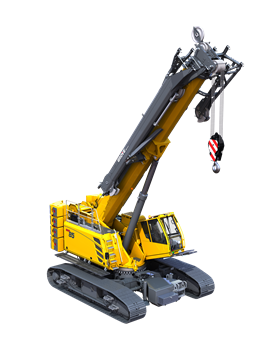
Grove GHC85
Capacity of crane: 85 tons
Main boom length: 137.8 feet
Fixed Jib Length: 49.3 feet
Maximum Line Speed: 360 ft/min
Boom Length with jibs: 187.1 feet
Total Tip Height: 199 feet
Counterweight: 62,391 pounds upper counterweight and carbody weight 37,478 pounds
Bigger and better
The largest challenge with telecrawlers is convincing customers to take a look at a different approach with their cranes.
“People have successfully used conventional lattice and rough terrains for years, so it is not always easy to convince them to bend that trend and try a different concept,” said Tadano’s Land. “The front-end cost of a telecrawler is generally higher compared to other cranes, so there can be some initial sticker shock. That hurdle diminishes once the customer tries it and realizes they can complete their work quicker, easier and more economically than with conventional cranes.”
The telescopic trend has shifted towards larger and larger machines. The 30 to 35-ton market used to be one of Tadano’s most popular classes, but not anymore.
“Units in the 75 to 140-ton range are easily our most popular requests, but we are really seeing requests for larger machines grow,” added Land. “The 200-250-ton market seems strong right now and has picked up immense popularity on the larger infrastructure projects. We believe there is a need for an even larger telecrawler market to replace some of the limited versatility lattice crawler products out there.”
The current Tadano telescoping crawler range is from 35 to 200-ton capacity range and up to 200 feet of main boom. Jib options are numerous with mechanical or hydraulic offset, heavy lift and long jib options available for a maximum lifting height of 302 feet. Models in the 35 to 150-ton capacity range feature a full power boom for easy operation and the ability to telescope large loads. Tadano’s 160-ton and 200-ton machines feature pin and latch booms for maximum boom length and reach. The standard is a triple grouser pad for maximum traction in poor ground conditions, but the company also offers flat, cast pads and even a poly pad option for surfaces that need to be protected from crawler tracks. All machines can be run with the tracks fully extended, retracted or even with asymmetric track extension configurations for maximum jobsite versatility on cramped footprints. A third winch option has also been added to the Tadano lineup due to customer demand. The company has also developed many specialty options such as hydraulic tool circuits and even a hydraulic powerpack mount that can be mounted in place of rear counterweight.
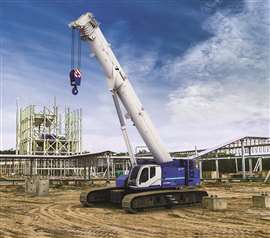
Tadano GTC-1600
Capacity of crane: 160 tons
Main boom length: 200.1 feet
Fixed Jib Length: 59.1 feet
Maximum Line Speed: 483.5 feet/min
Boom Length with jibs: 305.1 feet
Total Tip Height: 302 feet w/jib inserts
Counterweight: 70,100 pounds
A strong foundation
In light of supply chain issues across all sectors of the heavy lifting industry, Sany is still optimistic for brighter days ahead. The company believes 2023 numbers will be more positive as components are more readily available.
“Pre-cast construction and sound barrier work appears to be increasing,” said Joel Hicks, product manager crawlers, Sany. “That gives telescopic crawlers an advantage as they allow for reduced setup time and offer full pick and carry capabilities. Bringing the SCA1600TB, a 160-ton telescopic crawler, to the States makes sense for our customers.”
According to Hicks, in the North American telescopic crawler market, machine capacities over 105 tons represent 58 percent of the market, and in the rest of the world, that size machine only accounts for eight percent.
“It’s more balanced here so we have a strong opportunity for growth,” he said. “The 90-ton and 160-ton telescopic crawlers we brought to America first represent the majority of the market. It gives us a strong foundation on which to build out the full line.”
Having the right product at the right time to suit customer needs is always the biggest challenge for Sany.
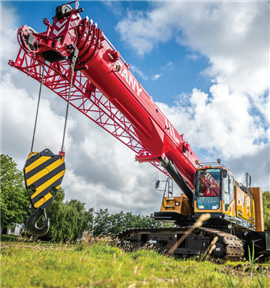
Sany SCA900TB
Capacity of crane: 90 tons
Main boom length: 40 to 154.2 feet
Fixed Jib Length: 33.5 to 57.4 feet
Maximum Line Speed: 339 feet/min
Boom Length with jibs: 154.2 + 57.4 feet
Total Tip Height: 209.9 feet
Counterweight: 57,300 pounds
upper counterweight and carbody weight 13,200 pounds
“Sany America is currently incorporating operator and buyer feedback to improve our machines for the jobs they will be doing in the future,” added Hicks. “The pre-cast industry is maturing and growing, which means it offers new challenges for end users. We noticed that operators were expressing the need for increased capacity and reach. This led to our development of a new heavy-duty fixed jib on Sany’s SCA1600TB telescopic crawler.”
Sany has a 90-ton telescopic crawler on the market right now and a 160-ton machine launching in early 2024. Together, they capture most of the customer demand, according to Hicks.
“As construction challenges are evolving, Sany America is looking at what makes sense to fill in the gaps between 50-ton to 250-ton machines,” said Hicks. “We are proud to say that all Sany cranes are backed by the industry’s strongest three-year/3,000-hour warranty and loaded with standard features including full camera and light packages.”
Liebherr manufactures four different telescopic crawlers, including the LTR 1040, LTR 1060, LTR 110 and LRT 1120. Frequent areas of use for Liebherr’s telescopic crawlers include prefabricated parts assembly, the energy sector, auxiliary crane jobs for erecting wind turbines and infrastructure projects.
According to Liebherr, telescopic crane customers say the advantages of these cranes include short set-up times, simpler transport and the variability of the boom system.
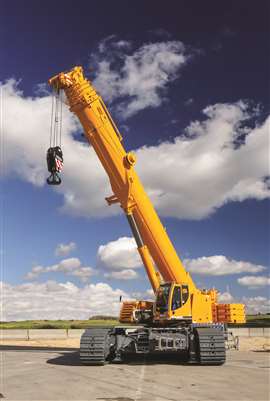
Capacity of crane: 250 tons
Main boom length: 197 feet
Fixed Jib Length: 11-foot assembly jib
Maximum Line Speed: N/A
Boom Length with jibs: 338 feet
Total Tip Height: 345 feet
Counterweight: 154,350 pounds
STAY CONNECTED


Receive the information you need when you need it through our world-leading magazines, newsletters and daily briefings.




